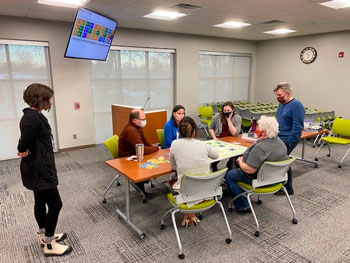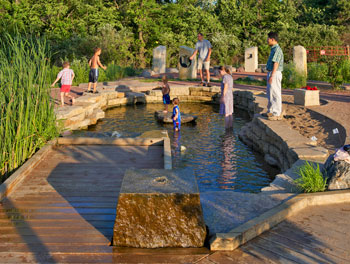The best parks and trails are nurtured through a planning process that engages many stakeholders.
By Molly Hanson
The importance of outdoor spaces has never been more evident. Now, we need new tactics and techniques if we’re going to create lasting change in our communities and ensure equitable access to our outdoor spaces.
It’s not hyperbole to say that the world has been turned upside down since the onset of the global COVID-19 pandemic in early 2020. In the first days, weeks and months of COVID-19, phrases like “social distancing” and “remote learning” quickly became part of our common language. Those who had the privilege to do so packed up their laptops and began working from home; restaurants and movie theaters shut down; sporting events were canceled.

Though it can be uncomfortable to think back to those hectic, scary and wholly uncertain early pandemic days, in doing so I’m also reminded of something: as our world was thrust into turmoil, people turned to parks and trails like they’d never done before. Outdoor community spaces became places where people could go to exercise, safely socialize, and, amid the chaos, gain a much-needed sense of peace and calm.
During the early stages of the pandemic, it became apparent that people really wanted to go outside. Across the country, some trail use spiked to levels more than 200% higher than the previous year, according to trail count data released by Rails-to-Trails Conservancy. With many indoor spaces either shut down or riskier to visit, people embraced the great outdoors, and these spaces served as powerful forces for well-being, showing marked benefits to our physical and mental health.
According to the Outdoor Foundation’s 2021 Outdoor Participation Trends Report, in 2020, 53% of Americans ages 6 and older participated in outdoor recreation at least once, the highest participation rate on record. Even more remarkably, 7.1 million more Americans participated in outdoor recreation in 2020 than in the year prior. In other words, the COVID-19 pandemic inspired marked participation growth and gains in outdoor experiences. The report explains that despite these gains, however, nearly half of the U.S. population did not share in the positive health outcomes of outdoor physical activity and access to outdoor spaces. Notably:
- Nearly 75% of outdoor participants were white.
- Participation rates declined 7% annually among Asian Americans for the past three years.
- Participation rates stagnated for the past three years among Black Americans.
- Though participation rates grew among Hispanic Americans, rates remained well below those of their white counterparts.
Knowing the importance of outdoor spaces amidst and beyond the pressures of a pandemic, and the apparent inequities in engagement with outdoor spaces, how can we engage with community members in a safe and meaningful way to ensure equitable access and create spaces that are welcoming and accessible to all?
In my role as RDG’s Conservation and Community Outreach Specialist, most of my time is spent helping facilitate and lead public engagement efforts and providing project management for our conservation-based projects. So, it’s only natural that this topic—the topic of equitable outdoor recreation and community engagement—is one in which I’m heavily invested. Meaningful projects don’t happen without meaningful engagement, and in a current and post-COVID environment, creating meaningful engagement opportunities requires that we learn new tactics and techniques if we want to continue to create lasting change in our communities and ensure equitable access in our outdoor spaces.
Evolving Community Engagement
Prior to COVID-19 and all the implications that followed, RDG’s Parks Studio had a toolbox of tactics that helped us talk to folks and garner feedback about concepts and ideas. In addition to hosting public meetings, we’d also do phone interviews, host focus group listening sessions, mail fliers, share curated social media content and conduct visual listening exercises. Many of these activities took place in person and often in large groups.
Insert the global pandemic, and everything we had been doing in-person had to be moved online. We had to figure out how to maintain connections to and between community members and find ways to offer meaningful public engagement and outreach in a physically distanced world.

To develop a solution to conduct public engagement amid COVID-19, it helps to remind ourselves what’s at the heart of community engagement. One of my favorite explanations of community engagement, from Penn State’s College of Agricultural Economics, Sociology and Education, defines it as “the process of working collaboratively with and through groups of people affiliated by geographic proximity, special interest or similar situations to address issues affecting the well-being of those people.” Community engagement is a powerful vehicle for bringing about environmental and behavioral changes that improve the health of a community and its members. It often involves partnerships and coalitions that help mobilize resources and influence systems, change relationships among partners and serve as catalysts for changing policies, programs and practices. Calling back to the core of what it means to connect with and listen to our communities helps us see how the changes we’ve made to our processes have helped move important projects forward, despite the challenges inherent in living in a socially distanced world.
The successes we’ve had over the past two years as we’ve continued to support communities through projects that include thoughtful housing assessments and culturally significant designs are a reflection of our ability to meet people where they are. These efforts also reflect a willingness to adapt even our most long-standing and ingrained approaches to engagement.
Changing and growing in three key areas has enabled us to serve our clients and projects well throughout the pandemic:
- A strong investment in technology and tools: Technology has played a critical role in helping us meet the challenges of the time. Our hybrid engagement strategies utilize a variety of both in-person and virtual tools that support adaptable and creative ways to engage with the public. Gone are the days of simply holding a public meeting to check a “public engagement box.” Today, state-of-the-art virtual reality technology, interactive mapping and translation tools, real-time survey data and easy-to-use custom project websites supplement roundtable discussions, listening sessions, intercept interviews and community open houses to help us meet people where they are, ensure their voices are heard and confirm they are reflected in the final design.
- An emphasis on diversity, equity and inclusion in both process and design: Since its inception, RDG’s Diversity, Equity and Inclusion Committee has led many ongoing internal education and advocacy efforts, including presentations on DEI-related topics and the development of an internal resource library. These internal efforts help guide our external work as we seek to create inclusive engagement strategies tailored to the unique communities we serve. The public engagement strategies we develop work in tandem with an integrated communications plan to support transparency and ongoing community engagement throughout each project, from kickoff through implementation. For these engagement practices to be successful, we rely on local partners to represent community values in a way that, as outsiders, we cannot. Those partners accelerate relationship building and allow us to cast a wider net of engagement to create a truer representation of the community.
- A commitment to sustainable practice: Our teams have experience in both LEED and WELL strategies and certifications, and we’re constantly looking for opportunities to advance health and well-being through building design that supports clients at the intersection of health, sustainability and climate resilience. This looks different for every client or community, but public engagement allows teams to connect and better understand not only people’s existing needs but also their hopes and dreams for the future. From resilient stormwater management strategies to relationships with local partners and supply chains to affordable maintenance plans, each project is an opportunity to consider how long-term viability and vitality will help communities across the country cut carbon emissions, improve ecosystem services and embrace climate adaptivity.
To reference Maya Angelou, when we know better, we do better. As we’ve moved through the past two years, we’ve continued to home in on best practices. For example, understanding that virtual engagement options must ensure participants have ample access to Wi-Fi and captions as part of presentations. Likewise, in-person events should feature kid’s stations so parents can bring them along, and these events should take place at locations with access to public transportation and bike parking. We are in the business of removing barriers and listening. We understand the more people we can engage in the process, the better the outcome.
The world looks different today than it did two years ago, and our processes reflect the changes we’ve experienced. One thing remains the same, however: people’s need for connection. We must commit to carrying the best of what we’ve learned through to the other side of the pandemic and continue striving to learn more and do better. Identifying gaps in access to recreation and public spaces can help us imagine ways to design more equitably. Everyone deserves access to our parks and trails, and to enjoy the stress-reduction benefits these natural spaces provide. It’s our job as designers and planners to help carve a path there. RM



